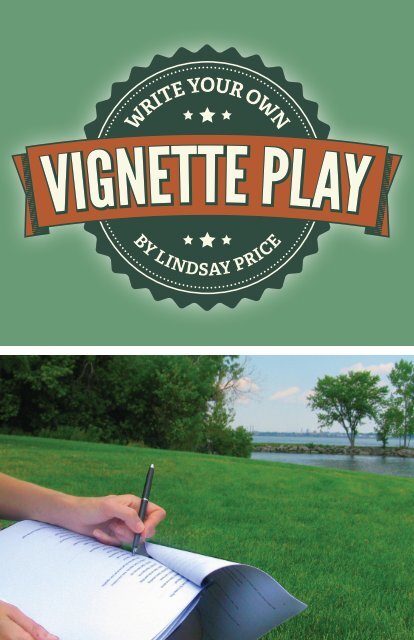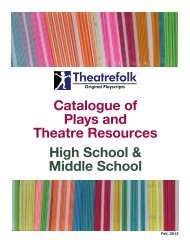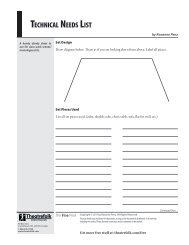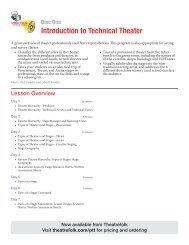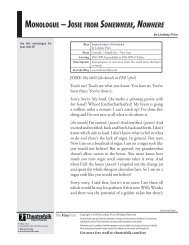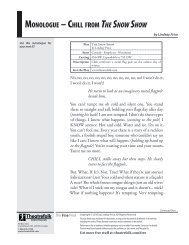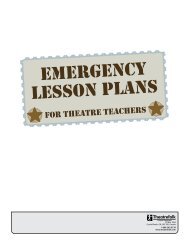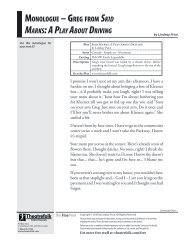Write Your Own Vignette Play - Theatrefolk
Write Your Own Vignette Play - Theatrefolk
Write Your Own Vignette Play - Theatrefolk
Create successful ePaper yourself
Turn your PDF publications into a flip-book with our unique Google optimized e-Paper software.
WRITE YOUR OWN<br />
BY LINDSAY PRICE
<strong>Write</strong> <strong>Your</strong> <strong>Own</strong> <strong>Vignette</strong> <strong>Play</strong><br />
Copyright © 2011 Lindsay Price & <strong>Theatrefolk</strong><br />
CAUTION: This book is fully protected under the<br />
copyright laws of Canada and all other countries of the<br />
Universal Copyright Convention.<br />
No part of this book covered by the copyrights hereon<br />
may be reproduced or used in any form or by any means<br />
- graphic, electronic or mechanical - without the prior<br />
written permission of the author.<br />
Published by:<br />
<strong>Theatrefolk</strong><br />
PO Box 1064<br />
Crystal Beach, ON, L0S 1B0<br />
Canada<br />
Tel 1-866-245-9138<br />
Fax 1-877-245-9138<br />
e-mail: tfolk@theatrefolk.com<br />
website: www.theatrefolk.com<br />
ISBN 978-1-926533-39-1
WRITE YOUR OWN<br />
BY LINDSAY PRICE<br />
Contents<br />
Introduction..............................................................................3<br />
Chapter One: What is a <strong>Vignette</strong> <strong>Play</strong>?.......................................5<br />
Chapter Two: Brainstorming....................................................11<br />
Chapter Three: The Theme.......................................................17<br />
Chapter Four: Improv..............................................................29<br />
Chapter Five: Getting it Down..................................................37<br />
Chapter Six: Processing Feedback............................................43<br />
Chapter Seven: Choosing and Shaping.....................................47<br />
Chapter Eight: The Nuts and Bolts...........................................51<br />
Appendix – Proper <strong>Play</strong> Formatting........................................57<br />
1
WRITE YOUR OWN<br />
BY LINDSAY PRICE<br />
Introduction<br />
You want to work with your students to write and<br />
perform an original play.<br />
BUT…<br />
»»<br />
You don’t know where to start.<br />
»»<br />
You’ve never written a play before.<br />
»»<br />
You don’t know how to corral a mass of ideas into a<br />
single focused piece.<br />
»»<br />
<strong>Your</strong> students have never written a play before.<br />
»»<br />
You have students who don’t feel creative.<br />
<strong>Write</strong> <strong>Your</strong> <strong>Own</strong> addresses all these issues and offers a<br />
step by step process from choosing a theme, to generating<br />
source material, to using improvisation, to a final draft.<br />
Use <strong>Write</strong> <strong>Your</strong> <strong>Own</strong> with a class, drama club, or summer<br />
group to write a play.<br />
3
4 <strong>Write</strong> <strong>Your</strong> <strong>Own</strong> <strong>Vignette</strong> <strong>Play</strong><br />
This volume of <strong>Write</strong> <strong>Your</strong> <strong>Own</strong> covers the <strong>Vignette</strong><br />
<strong>Play</strong>. The <strong>Vignette</strong> <strong>Play</strong> is an easily adaptable format which<br />
applies multiple strategies (brainstorming, planning,<br />
experimenting, communicating, revising, presenting) and<br />
is an excellent method for group-created original theatre.<br />
It works especially well for groups with varying levels<br />
of confidence when it comes to writing. By the end, all<br />
students will feel able to contribute to the writing process<br />
regardless of natural writing ability.
WRITE YOUR OWN<br />
BY LINDSAY PRICE<br />
Chapter One: What is a <strong>Vignette</strong> <strong>Play</strong>?<br />
What is a <strong>Vignette</strong> <strong>Play</strong> and why is it suitable for<br />
original play creation?<br />
A<br />
vignette is a short scene. A <strong>Vignette</strong> <strong>Play</strong> is a script<br />
made up of vignettes, centering on a theme.<br />
So instead of the play having one story with a beginning,<br />
middle and end, each scene is a complete story. Each scene<br />
shows a different take or interpretation of the theme. Each<br />
scene can explore a different style, from traditional, to<br />
monologue, to tableau, to abstract, to musical.<br />
<strong>Vignette</strong> <strong>Play</strong> Examples<br />
I have written a number of <strong>Vignette</strong> <strong>Play</strong>s:<br />
Wait Wait Bo Bait<br />
Theme: Waiting<br />
Scene Examples:<br />
5
6 <strong>Write</strong> <strong>Your</strong> <strong>Own</strong> <strong>Vignette</strong> <strong>Play</strong><br />
»»<br />
Two boys wait outside the principal’s office<br />
awaiting their punishment.<br />
»»<br />
A girl waits by the phone for a boy to call her.<br />
»»<br />
Kids waiting to open their Christmas presents.<br />
»»<br />
A girl wants to know how long she should wait<br />
for the man of her dreams.<br />
»»<br />
A student worries as she waits to make a class<br />
presentation.<br />
This Phone Will Explode at the Tone<br />
Theme: Communication – how we do and how we<br />
don’t.<br />
Scene Examples:<br />
»»<br />
Two girls talk about their troubles in the middle<br />
of the night.<br />
»»<br />
A boy works up the courage to ask a girl out.<br />
»»<br />
Dealing with an obscene phone caller.<br />
»»<br />
Two guys have the worst conversation ever.<br />
»»<br />
The phone police.<br />
Hairball<br />
Theme: Hair<br />
Scene Examples:<br />
»»<br />
A boy wants to know how long he has before<br />
going bald.<br />
»»<br />
A girl gets angry at her boyfriend when he<br />
insults her hair.<br />
»»<br />
A girl with cancer tries on wigs.<br />
»»<br />
The bad haircut.
Chapter One: What is a <strong>Vignette</strong> <strong>Play</strong>? 7<br />
»»<br />
The psychology of the hair puller.<br />
»»<br />
Going blonde, Shakespeare style.<br />
The possibilities are endless when it comes to the <strong>Vignette</strong><br />
<strong>Play</strong>. Any avenue is possible: teen issues, school issues, the<br />
environment, current events, historical events, headlines,<br />
war, the economy, the list goes on.<br />
Why use the <strong>Vignette</strong> <strong>Play</strong>?<br />
Flexible Casting: Because the play focuses on short scenes,<br />
there isn’t a set character list. If you have actors who are<br />
showing less commitment, if you have actors who drop<br />
out, if you have actors who want join in, you can change<br />
the casting.<br />
Broad Appeal: This format is excellent for a variety of<br />
groups. It works well as a project for a class that has little<br />
theatrical experience. It works well for a drama club that<br />
wants to write their own play for competition. It works<br />
well in a summer camp scenario where participants may<br />
not know each other well.<br />
Flexible Rehearsals: With multiple scenes, you can have<br />
more actors working at the same time, rather than actors<br />
sitting around until their turn onstage.<br />
More Control: There’s more control in multiple authors<br />
writing multiple short scenes, rather than trying to coordinate<br />
a group to agree on and write one single story.<br />
The Ability to Give Students Control: The class play<br />
project is an excellent student-driven assignment. In some<br />
situations it has been used as a final exam. The project
8 <strong>Write</strong> <strong>Your</strong> <strong>Own</strong> <strong>Vignette</strong> <strong>Play</strong><br />
allows you to observe the work ethic of your students, their<br />
team-building skills, how they handle the decision-making<br />
process when they are in control. These are all assessable<br />
skills that rely less on the difficult-to-quantify notion of<br />
“creativity.”<br />
Multiple Authors: It is easier to encourage different<br />
writing voices in the absence of a single story. Scenes can<br />
have different viewpoints, different tones, and explore<br />
different genres. Actors who take part in the creation feel<br />
more ownership of the play.<br />
Economical Staging: <strong>Vignette</strong> <strong>Play</strong>s work best with sparse<br />
staging and costuming. With multiple short scenes, it’s<br />
better to have a unit set (cubes and risers) that can be used<br />
over and over again instead of a specific set for each scene.<br />
A specific set requires the play to stop every two to three<br />
minutes for a scene change, breaking the flow of the play.<br />
The same applies for costuming. Use a neutral costume that<br />
works for all the scenes with perhaps some hand props or<br />
small costume pieces that can be easily and swiftly added<br />
on.<br />
How long should a <strong>Vignette</strong> <strong>Play</strong> be?<br />
Because you’re working with scenes on a theme, rather<br />
than the development of a single story, 30 minutes is an<br />
ideal length for the <strong>Vignette</strong> <strong>Play</strong> – it’s short enough to<br />
keep an audience and long enough to give the group a<br />
substantial creation project. An audience will hang in and<br />
be interested in scene work, but after awhile there needs to<br />
be a developing story to hold them.
Chapter One: What is a <strong>Vignette</strong> <strong>Play</strong>? 9<br />
How many actors are in a <strong>Vignette</strong> <strong>Play</strong>?<br />
This is completely up to you! Flexible casting is at the heart<br />
of the <strong>Vignette</strong> <strong>Play</strong>. You can have each actor perform in<br />
only one scene (and so have a very large cast) or you can<br />
have actors perform in multiple scenes (for a smaller cast).<br />
What are the steps to writing a <strong>Vignette</strong> <strong>Play</strong>?<br />
This guide will offer a step-by-step process designed to help<br />
get your group efficiently and effectively to a final product:<br />
»»<br />
Establish and practice how to brainstorm in<br />
groups.<br />
»»<br />
Establish and practice how to brainstorm<br />
individually.<br />
»»<br />
Decide on a theme.<br />
»»<br />
Improv on the theme in a theatrical context.<br />
»»<br />
Start the formal scene-writing process.<br />
»»<br />
Decide on the shape of the play.<br />
»»<br />
Assemble the first draft.<br />
»»<br />
Record and organize.<br />
»»<br />
Move beyond the first draft.<br />
»»<br />
Choose a title.<br />
»»<br />
The final product.<br />
The first thing to notice is that writing scenes does not<br />
occur immediately in this process. It’s vital that students
10 <strong>Write</strong> <strong>Your</strong> <strong>Own</strong> <strong>Vignette</strong> <strong>Play</strong><br />
don’t start writing scenes as their first step. While this may<br />
seem counter-productive (you are working on a play after<br />
all) it’s very purposeful.<br />
Following each step is especially important if you have<br />
students who feel insecure in their ability to write. Every<br />
class has one or two students who already have the natural<br />
instinct to write a play. But this is a group project and<br />
that means there are 20-30 students who don’t have that<br />
instinct. These steps are going to encourage insecure<br />
students, providing them with a process that they’ll be able<br />
to use in any writing situation.<br />
Continue writing your<br />
<strong>Vignette</strong> <strong>Play</strong>!<br />
Order <strong>Write</strong> <strong>Your</strong> <strong>Own</strong> <strong>Vignette</strong> <strong>Play</strong> now at<br />
theatrefolk.com/write-vignette


